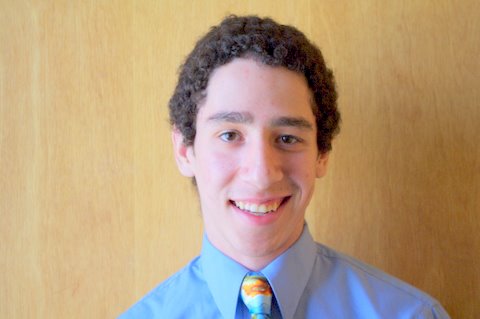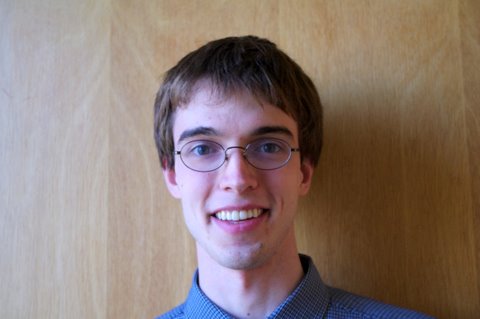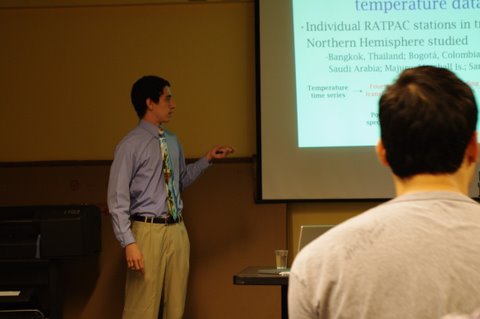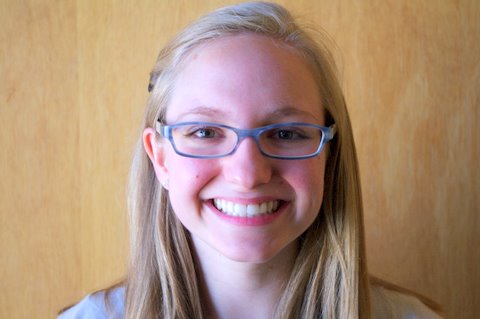PAOC Spotlights
Senior Theses - 2011
Friday, May 13th, was the EAPS annual senior thesis presentation day. Of the eight Course 12 seniors participating, three, Anastasia Maheras, John (Vince) Agard and Todd Mooring, were advised by PAOC faculty.
Anastasia Maheras (Environmental Science) has been working with Prof. Noelle Eckley Selin comparing atmospheric mercury observations with results from a chemistry transport model used to inform policy development and regulation.
John (Vince) Agard (Atmospheres, Oceans & Climate) has been working with Prof. Kerry Emanuel looking at a quasi-decadal signal observed in the lower stratosphere seeking possible connections to known oscillatory phenomena such as ENSO.
Todd Mooring (Atmospheres, Oceans & Climate) has been working with Prof. Paul O'Gorman looking at how the length of atmospheric eddies increases in simulations of future global warming.
Read on to savour a taste of each of their projects:
Elemental and Reactive Gaseous Mercury Deposition and Diurnal Cycles over Terrestrial Environments
Anastasia Maheras (advisor Prof. Noelle Eckley Selin)
Anastasia has been studying the atmospheric component of the global biogeochemical mercury cycle to determine the mechanisms behind diurnal trends and amplitudes in elemental and reactive gaseous mercury concentrations over terrestrial environments. Using the 3D chemical transport model GEOS-Chem to compare with results from a one box model of her own devising, Anastasia was able to investigate how well GEOS-Chem was able to repoduce detailed local behaviors.
Mercury is a significant neurotoxin for humans and other species that is being addressed in the policy realm on both national and international levels. Being able to model atmospheric mercury processes correctly is an important part of regulation and policy drafting.

Comparing GEOS-Chem model results with measurements for three sites in Nevada (Weiss-Penzias et al. (2009)) Anastasia attributed the significant differences in elemental mercury concentrations she found to an under-representation of mercury emissions at naturally enriched sites and reactive gaseous mercury diurnal variations that differed by a factor of 3-4, with GEOS-Chem underestimating the diurnal trend.
Based on the diurnal nature of this error, Anastasia was able to conclude that for her test site, GEOS-Chem under represents the magnitude of elemental mercury emissions, the amount of oxidation occurring in the atmosphere, and the scale of entrainment from the free troposphere.
A Global and Tropical Quasi-Decadal Oscillation of the Atmosphere and Ocean
John Vincent Agard (advisor Prof. Kerry Emanuel)

Using power spectrum analysis and Fourier decomposition Vince showed how he had been able to characterize the temporal and vertical manifestations of the signal and use EOF analysis to analyze its spatial characteristics.
Finding that the signal in the SST data displayed significant coherence with similar oscillatory signals in ENSO (the El Nino Southern Oscillation), PDO (Pacific Decadal Oscillation) and AMO (Atlantic Multidecadal Oscillation) indices, Vince concluded that the observed oscillation was more likely to be related to them than the (~11 year) solar activity cycle - an alternative suggested candidate.

Finally, Vince demonstrated how the lower stratospheric temperature signal provided a small but measurable contribution to the signal of tropical cyclone potential intensity in the Atlantic MDR (Main Development Region).
Vince looks forward to further exploring the causal origins of this phenomenon as he returns to work with Kerry Emanuel as a graduate student this fall.
Changes in Atmospheric Eddy Length with the Seasonal Cycle and Global Warming
Todd A. Mooring (advisor Prof. Paul A. O'Gorman)

Todd demonstrated that an effective Rossby radius that takes into account the effects of water vapor on the dynamics of the atmosphere was better than the traditional dry Rossby radius in explaining the seasonal cycle of eddy length in the northern hemisphere. This improvement was found to be contingent upon the choice of the free troposphere depth as the height scale in the Rossby radius calculation (no improvement was seen if the scale height was chosen instead).

PAOC congratulates all three seniors for their hard work and looks forward to following their graduate careers with interest.

